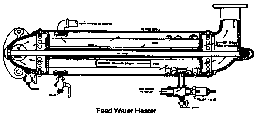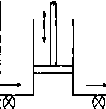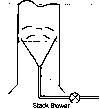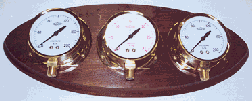
|
Feed Water: Any subject under discussion among
steamboaters inevitably turns to feed water failures. It is well
worth repeating that all steam systems should have at least three
separate means of introducing water to the boiler when at maximum
pressure. |
||
|
to increase the heat transfer
area. Two things to remember: make the connections so that
the flow of the exhaust steam and of the feed water are in opposite
directions, and keep the higher pressure feed water in the inside pipe
or group of tubes. |
||
|
Most common and most successful is the
force pump. A simple cylinder with a reciprocating piston
alternately draws water into the cylinder and forces it out into the |
||


|
Stack Blower: Some boilers require an aid to draft
during fire startup, or when maximum steam production is desired.
A stack blower is generally fitted to provide this draft. Just
pick up dry steam from the main steam line using a relatively small
line and valve. |
||
|
boiler, the direction of flow
determined by two check valves. Mechanically driven pumps may be
operated from the main shaft through spur gears, or sprockets and
chain, or from one of the crossheads through a suitable yoke or other
linkage. Hand operated pumps use a lever attached to the
piston. Some mechanical pumps use four check valves, each pair
acted on by opposite sides of the piston. |
||

|
Pass this line back into the boiler
where the steam becomes superheated and even drier. A nozzle
directed up the stack is placed several |
||
|
inches (say half an stack diameter)
from the bottom of the stack. Three small holes in a fitting at
the end of the pipe directed so as to make a cone with an included
angle of 60 to 90 degrees will work well to direct the ejecting steam
up the stack. |
||


|
Pressure Gages Boiler
Safety: A
boiler deserves all the care it can get. The exterior should be
kept clean and painted. Make certain the base of the boiler is
not sitting constantly in a puddle of water, Keep wet ashes out
of the ash pit so that it doesn't start rusting around the edges.
|
||
|
Safety Valves: Safety valves are held closed by a
spring whose tension may be adjusted. It is wise and prudent to
rely on a certified valve repair shop or the factory to set safety
valves by comparison to calibrated gages. |
||

|
After so adjusted, safety valves
should be left alone, in fact most are sealed to insure that this
occurs. discharge from the safety valve is burning hot,
under pressure and hence dangerous. It should be led vertically
through the canopy, or through the side of the boat and aimed down. |
||
|
Preheating: Preheating the boiler water is
generally accomplished by a simple heat exchanger which may be just one
pipe inside another or a bundle of inside pipes or tubes so as |
||